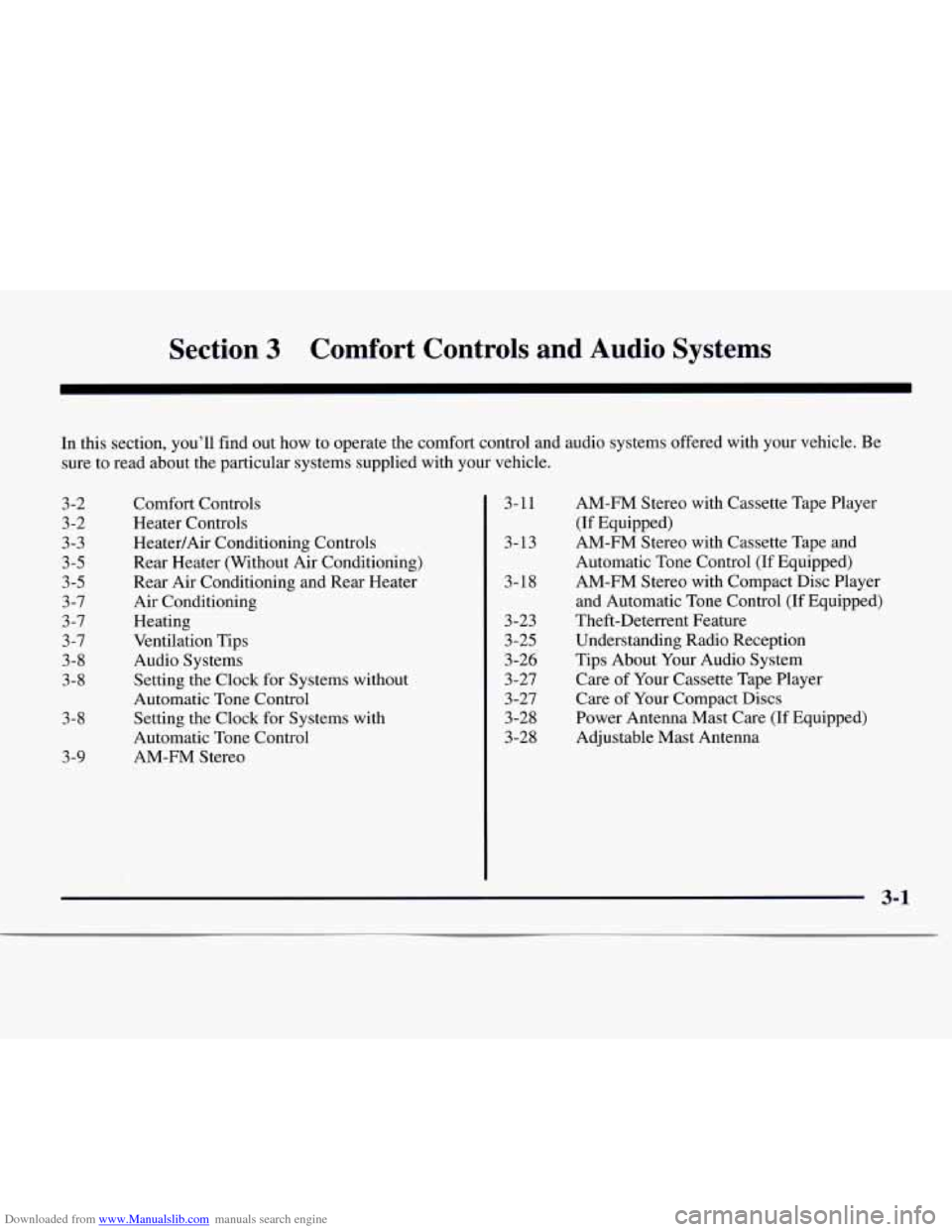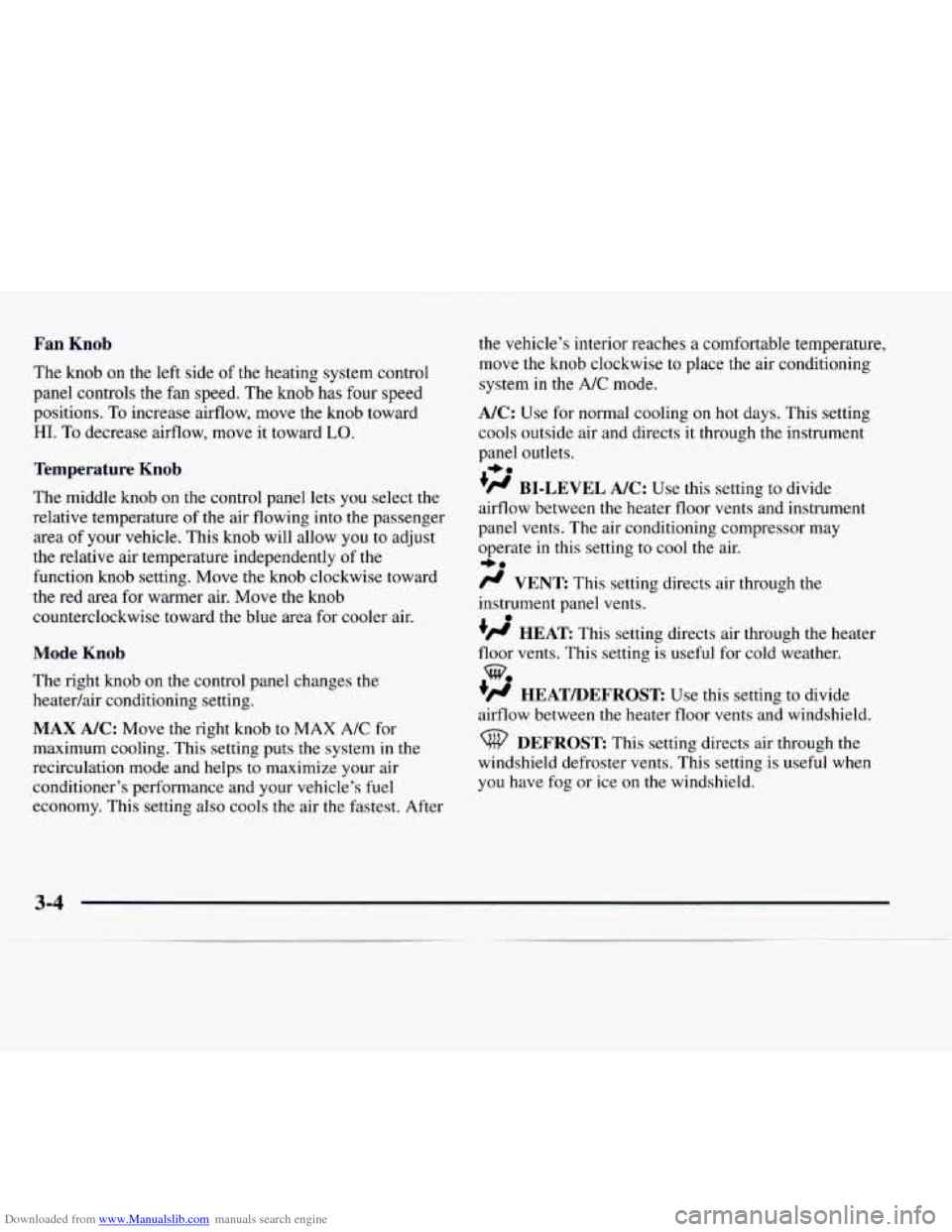Page 75 of 386

Downloaded from www.Manualslib.com manuals search engine Both rear doors can be opened past 90 degrees by
opening the doors past the first detent
(90 degrees open),
then opening fully.
To close the rear doors, close the driver side rear door
first. Then, close the passenger side rear door. Check
to
make sure both doors are completely closed.
I-
It can be dangerous to drive with the rear doors
open because carbon monoxide (CO) gas can
come into your vehicle. You can’t see or smell
CO.
It can cause unconsciousness and even death.
CAUTION: (Continued) CAUTION:
(Continued)
I
If you must drive with the rear doors open or if
electrical wiring or other cable connections must
pass through the seal between the body and the
rear doors:
Make sure all windows are shut.
lbrn the fan on your heating or cooling
system to its highest speed with the setting
on VENT, HEAT, BLEND or DEF.
Additionally, on vehicles with heatingair
conditioning systems, NORM A/C or
BI-LEV A/C can
be used. That will force
outside air into your vehicle. See “Comfort
Controls” in the Index.
instrument panel, open them all the way.
If you have air outlets on or under the
See “Engine Exhaust” in the Index.
Page 92 of 386

Downloaded from www.Manualslib.com manuals search engine Rear Swing-Out Window
To close the window, pull the latch toward you and push
down
on the latch to lock it. Your rear swing-out
windows
work the same way, but the latch is at the
bottom edge of the window.
It can be dangerous to drive with the rear
swing-out windows or rear door@) open because
carbon monoxide
(CO) gas can come into your
vehicle. You can’t see
or smell CO. It can cause
unconsciousness and even death.
If you must drive with the rear swing-out
windows or rear door(s) open or if electrical
wiring or other cable connections must pass
through the seal between the body and the rear
swing-out windows or rear door(s):
0 Make sure all windows are shut.
Thrn the fan on your heating or cooling
system to its highest speed with the setting on
VENT,
HEAT, BLEND or DEE Additionally,
on vehicles with heatingair conditioning
systems,
NORM A/C or BI-LEV A/C can be
used. That will force outside air into your
vehicle. See “Comfort Controls’’ in the Index.
instrument panel, open them
all the way.
0 If you have air outlets on or under the
See “Engine Exhaust” in the Index.
2-31
Page 107 of 386
Downloaded from www.Manualslib.com manuals search engine NOTICE:
Holding a cigarette lighter in with your hand
while it is heating can make it overload,
damaging the lighter and the heating element.
Just push the lighter all the way in and let go. When it’s done, it
will pop back by itself.
To remove the front ashtray, pull up on the tab with a
key or screwdriver inserted in the tab, and lift the
ashtray
out.
Sun Visors
To block out glare, you can swing down the
can also swing them from side
to side. Your visors.
You
visors have
elastic straps you can use to hold items such as maps.
Visor Vanity Mirror (Option)
Some visors have illuminated mirrors on them. Pull the
visor down and lift the mirror cover (if there is one), to
use the mirror.
2-46
Page 120 of 386

Downloaded from www.Manualslib.com manuals search engine Listed are four situations you may experience with your
fuel gage:
0
0
0
0
At the gas station, the fuel pump shuts off before the
gage reads
FULL (F).
It takes a little more or less fuel to fill up than the
fuel gage indicated. For example, the gage may have
indicated the tank was half full, but it actually took a
little more or less than half the tank’s capacity to
fill
the tank.
The gage moves a little when you turn
a corner or
speed up.
The gage doesn’t
go back to EMPTY (E) when you
turn off the ignition.
None
of these indicate a problem with the fuel gage.
Engine Coolant Temperature Gage
This gage shows the engine
gage pointer moves into
the red area your engine is
coolant
temperature.
If the
’% 260
too hot!
It means that your engine coolant has overheated. If
you have been operating your vehicle under normal
operating conditions,
you should pull off the road, stop
your vehicle, and turn
off the engine as soon as possible.
In “Problems on the Road,” this manual shows what to
do. See “Engine Overheating” in the Index.
Page 126 of 386

Downloaded from www.Manualslib.com manuals search engine Section 3 Comfort Controls and Audio Systems
In this section, you’ll find out how to operate the comfort control and audio systems offered with your vehicle. Be
sure to read about the particular systems supplied with your vehicle.
3-2 3-2
3-3
3-5
3 -5
3
-7
3 -7
3 -7
3-8
3-8
3-8
3
-9
Comfort Controls
Heater Controls
Heater/Air Conditioning Controls
Rear Heater (Without Air Conditioning)
Rear Air Conditioning and Rear Heater
Air Conditioning
Heating
Ventilation Tips
Audio Systems
Setting the Clock for Systems without
Automatic Tone Control
Setting the Clock for Systems with
Automatic Tone Control
AM-FM Stereo 3-11
3-13
3-18
3-23
3-25
3-26
3-27
3
-27
3-28
3-28 AM-FM
Stereo with Cassette Tape Player
(If Equipped)
AM-FM Stereo with Cassette Tape and
Automatic Tone Control (If Equipped)
AM-FM Stereo with Compact Disc Player
and Automatic Tone Control
(If Equipped)
Theft-Deterrent Feature
Understanding Radio Reception
Tips About Your Audio System
Care of Your Cassette Tape Player
Care
of Your Compact Discs
Power Antenna Mast Care
(If Equipped)
Adjustable Mast Antenna
Page 127 of 386

Downloaded from www.Manualslib.com manuals search engine Comfort Controls
This section tells you how to make your air system
work for you. Your comfort control system uses
ozone-friendly
R- 134a refrigerant.
With these
systems, you can control the heating,
cooling and ventilation
in your van. Your vehicle also
has a flow-through ventilation system described later
in this section.
Heater Controls
If your vehicle does not have air conditioning, your
heater controls will look like this.
Fan Knob
The left knob of the heating system control panel
controls the fan speed. The knob has four speed
positions. To increase airflow, move the knob toward
HI. To decrease airflow, move it toward LO. To turn the
fan off, move the mode knob on the far right to OFF.
Temperature Knob
The middle knob panel lets you select the relative
temperature of the air flowing into the passenger area
of your vehicle. This knob will allow
you to adjust the
relative air temperature independently of the function
knob setting. Move the knob clockwise toward the red
area for warmer air. Move the knob counter clockwise
toward the
blue area for cooler air.
3-2
Page 129 of 386

Downloaded from www.Manualslib.com manuals search engine Fan Knob
The knob on the left side of the heating system control
panel controls the fan speed. The knob has four speed
positions. To increase airflow, move the knob toward
HI. To decrease airflow, move it toward LO.
Temperature Knob
The middle knob on the control panel lets you select the
relative temperature of the air flowing into the passenger
area
of your vehicle. This knob will allow you to adjust
the relative air temperature independently
of the
function knob setting. Move the knob clockwise toward
the red area
for warmer air. Move the knob
counterclockwise toward the blue area for cooler air.
Mode Knob
The right knob on the control panel changes the
heatedair conditioning setting.
MAX A/C: Move the right knob to MAX A/C for
maximum cooling. This setting puts the system in the
recirculation mode and helps to maximize your air
conditioner’s performance and your vehicle’s fuel
economy. This setting also cools
the air the fastest. After the vehicle’s interior reaches
a comfortable temperature,
move the knob clockwise to place the air conditioning
system in the
A/C mode.
A/C: Use for normal cooling on hot days. This setting
cools outside air and directs it through the instrument
panel outlets.
‘fl BI-LEVEL A/C: Use this setting to divide
airflow between the heater floor vents and instrument
panel vents. The air conditioning compressor may
operate in this setting to cool the air.
/J VENT This setting directs air through the
instrument panel vents.
+H HEAT This setting directs air through the heater
floor vents. This setting is useful for cold weather.
+# HEATmEFROST: Use this setting to divide
airflow between the heater floor vents and windshield.
+e
I,.
0
we
DEFROST This setting directs air through the
windshield defroster vents. This setting is useful when
you have fog or ice
on the windshield.
3-4
-
Page 131 of 386
Downloaded from www.Manualslib.com manuals search engine For warmer air, turn the knob clockwise toward the red
side, and for cooler air, turn the knob counterclockwise
toward the blue side.
To regulate the airflow location, adjust the center knob
on the control panel. Turn the knob counterclockwise
for floor vent airflow or clockwise for headliner vent
airflow. Generally, the upper vents are used for air
conditioning and the floor vents
for heating. The
control knob can be set to any blend setting.
To adjust the airflow speed, turn the fan control knob
on the
left side of the control panel to the desired
blower setting.
To activate the rear control, move the fan knob on the
front control to REAR CNTL. Rear Passenger Control
The rear control works just like the front control. It will
allow second seat passengers to adjust the controls as
they desire.
3-6